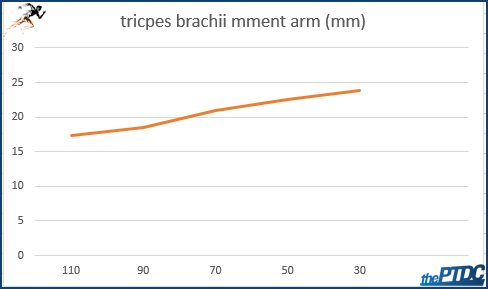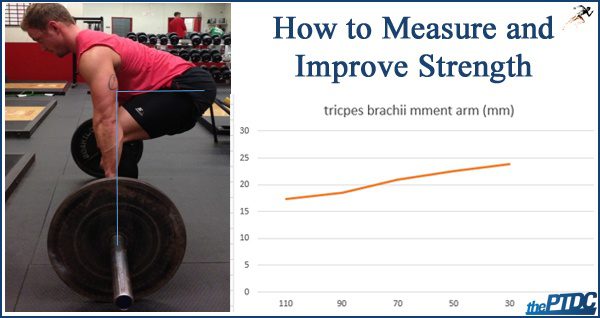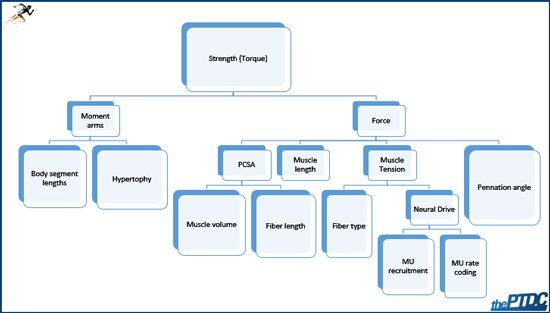As trainers or coaches we all deal with strength in one way or another. All trainers understand that when their client or athlete works against a resistive load they are demonstrating their strength.
Throughout the last year I've devoted a lot of time to studying and understanding the factors that go into strength expression.
While this article sways more to the side of educational rather than practical I believe it's important to have a basic understanding of something that we deal with every day.
I'm going to break down the factors that contribute to the expression of strength into two categories:
- modifiable
- temporary
(you'll see that this is highly abridged).
But before that we need to find an acceptable definition for strength.
Definition of Muscle Strength
Here are a few from the literature:
- "The amount of force that can be generated externally" (Young and Bilby)
- "The ability of a given muscle or group of muscles to generate muscular force under specific conditions" (Verkhoshansky & Siff)
- "The magnitude of variable force that muscles exert on the skeletal system...strength capacity may change with varying joint angles" (Kulig, Andrews, Hay)
I believe the last definition is the best one as it includes joint angle as a factor in strength expression. To understand why this is important torque/moment needs to be covered.
What is Torque/Moment
Torque describes strength and in the context of weightlifting can be internal or external. Torque has two components, moment arms and force (Torque = moment arm x force).
Movements have moment arms (external) and muscles have moment arms (internal). For example, in a deadlift the horizontal distance from the hips to a perpendicular line from the center of the barbell is the external moment arm whereas the muscles moment arm is calculated by taking the perpendicular distance from the joint center to the muscles line of pull.
Internal moment arms are difficult to calculate, and like external moment arms consistently change throughout a lift.

*the horizontal line in this picture is an example of the external moment arm length, the external moment arm is going to be much larger than the internal moment arm, putting the muscles at a mechanical disadvantage*
If 135 pounds is on the bar (see picture above) then the amount of force that the lifter has to produce to move the bar off the floor can be determined by comparing internal and external torque. I'll break down this equation until muscle force is the only variable on the left side of the equation.
Torque (internal) > Torque (external)
Moment arm (internal) x Muscle force > Moment arm (external) x Barbell load
Muscle force (internal) > {Moment arm (external) x Barbell load}/ Moment arm (internal)
We know the load, 135lbs (this is expressed in Newtons in the equation- 600 N) so we can arbitrarily give values to the external and internal moment arms (obviously we don't do this in real research). We can say the external moment arm is .5 meters and the internal moment arm is .05 meters.
Muscle force (internal) > {.5m x 600N}/.05 m
Muscle force (internal)> 300 N·m/.05m
Muscle force (internal) therefore must be greater than 6,000 Newtons or almost 1350 pounds of force (ten times the barbell load). This is simplified, in the deadlift with multiple muscles contributing to force production, calculating necessary force is more complex.
As the joint angle changes, both internal and external moment arms change, thus the muscular force demand at one point in a lift is completely unique to that one point.
Furthermore, as a muscles length changes, its ability to actually produce force changes. As a muscle shortens it loses its ability to produce force. How a muscle's force producing capabilities change is described by length tension relationships.
For increased comprehension of this topic here's a graph of how the internal moment arm of the triceps change during elbow extension.

*as the elbow extends, decreasing the angle of flexion, the triceps moment arm increases, thus if force production capabilities remain the same then torque (strength expression) increases. These data points are from Sugisaki et al. 2010*
To comprehensively cover every factor that contributes to strength expression could take up an entire book. For example, the chart below list some of these factors.
For the sake of time, modifiable aspects of strength will be broken down into morphological (hypertrophy) and neurological changes whereas fatigue will cover temporary changes in strength expression.
Muscle Hypertrophy
Muscle hypertrophy is an increase in muscle cross sectional area. This augmented cross sectional area increases the number of contractile units which increases force production.
This is pretty straight forward and is generally well known and widely accepted that bigger muscles can produce more force than smaller muscles.
However a few interesting things happen when a muscle hypertrophies. Namely, an increase in muscle pennation angle and potentially increasing muscle moment arms.
Pennation Angle
As a muscle gets bigger their angle of pennation increases in order to fit more muscle fibers in a given space. More muscle fibers within a given space means greater force production.
However, the muscles line of pull changes so that direct force transmission decreases. Despite increased contractile capabilities the increased oblique pull has detrimental effects on each fiber.
In a review by Folland and Williams the authors state that,
"As the angle of fibre pennation increases, there's increased packing of muscle fibres within the same anatomical cross sectional area, but less force from each fibre is resolved to the tendon due to their increasingly oblique angle of pull. Therefore, the effect of angle of pennation on strength is a trade-off of these two factors (packing vs mechanical disadvantage)"
The video below does a good job of illustrating muscle fiber pennation:
Muscle Moment Arm
The research may be equivocal but it seems that as a muscle hypertrophies its internal moment arm increases, likely because the muscle belly is pushed outwards. Basically, the muscles force producing capabilities increase along with its moment arm, having positive effects on both components that influence torque!
*see Sugisaki et al., 2010*
Neurological Changes Affecting Strength
Neural drive refers to the efficiency of the nervous system. Force production is dependent on motor unit recruitment:
and motor unit firing frequency.
If a load increases or if fatigue sets in, more muscle fibers are recruited and their firing frequency also increases to maintain the same force output.
Check out a video covering action potentials to help you understand fatigue here:
https://www.youtube.com/watch?v=y7X7IZ_ubg4
At 85% of maximum voluntary contraction essentially all motor units are recruited, therefore firing frequency (how quickly motor units discharge action potentials) contributes to the further increase in force.
Some muscles rely more on recruitment than firing frequency to produce force and some rely more on firing frequency than recruitment to produce force.
While increased recruitment of muscle fibers and increased firing frequency explain what happens to the body as a load increases it probably doesn't fully explain how a person's nervous system becomes more efficient with resistance training.
It's likely, that as a person learns a new lifting movement they become more efficient at it. In this sense we would consider strength a skill that can be learned.
For example, more advanced squatters will use a more mechanically efficient technique (they lean forward less, generate greater velocities prior to the sticking region, descent into the squat in a more controlled manner, etc.)
While it's generally accepted the neurological changes occur with resistance training the mechanism to its contribution to increased strength isn't as clear cut as it is when hypertrophy occurs.
Fatigue Strength Reduction Factor
This could potentially be one of the most important factors that a trainer has to deal with. Fatigue will clearly have negative influences on performance. Fatigue is a complex, multifactorial process that begins as soon as exercise is initiated. One of the most interesting aspects of fatigue is that it is task dependent.
For example, if a client performs a 1RM bench attempt, the reason they would fail on their second repetition attempt will be different from why the client misses their last rep on a 15RM bench press set.
Also the mechanism for why the client missed their last rep on that 15RM bench press will be different on their third set than the first set!
Fatigue is generally regarded as peripheral or central. Central fatigue occurs proximal to the neuromuscular junction whereas central fatigue occurs proximally and has to do with inhibition of the contractile process.
The contributions that each type of fatigue adds to overall fatigue is probably dependent on the intensity of the training load.
For example, high intensity low repetition routines have a greater impact on central fatigue than a routine with moderate intensity and high volume (see Walker et al.).
So what does that mean for the trainer? In theory a program plan that stresses various systems at different times may help minimize overall fatigue. One day may be devoted to heavier weights with lower reps (central fatigue) whereas another day may focus on moderate weight with higher reps (peripheral fatigue).
Conclusion
If you're a trainer or coach and using resistance training for a client or athlete, the clear goal is to get them stronger. To what extent your client wishes to increase muscle strength is dependent upon their goals but regardless, increased strength has considerable health and lifestyle benefits.
Having a better understanding of some of the factors that contribute to muscle strength expression is vital for a well-educated trainer.
References
Kent-Braun JA. Central and peripheral contributions to muscle fatigue in humans during sustained maxial effort. Eur J Appl Physiol 80: 57-63, 1999.
Kulig K, Andrews JG, and Hay JG. Human strength curves. Exerc Sport Sci Rev 12: 417-466, 1984.
Sugisaki N, Wakahara T, Miyamoto N, Murata K, Kanehisa H, Kawakami Y, and Fukunaga T. Influence of muscle anatomical cross-sectional area of the moment arm length of the triceps brachii muscle of the elbow joint. J Biomech 43: 2844-2847, 2010.
Verkhoshanksy, Yuri Vitalievitch, and Mel Cunningham. Siff. (2009). Supertraining. Rome, Italy: Verkoshanksy. Print.
Walker S. Davis L, Avela J, and Hakkinen K. Neuromuscular fatigue during dynamic strength and hypertrophic resistance loadings. J Electromyogr Kinesiol. 22: 356-362, 2012.
Young WB and Bilby G. The effect of voluntary effort to influence speed of contraction on strength, muscular power, and hypertrophy development. J Strength Cond Res 7: 172-178, 1993.












